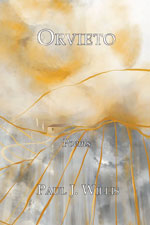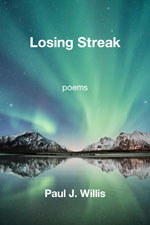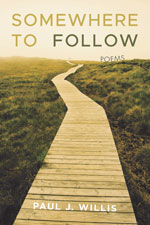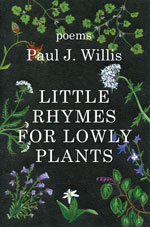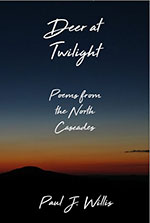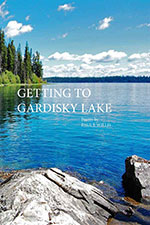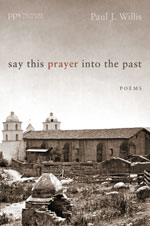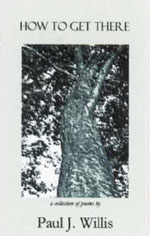 Paul J. Willis’s poems have appeared in hundreds of publications, including Best American Poetry (1996), Poetry magazine,Wilderness, and Christian Century. Garrison Keillor has read his poetry on the Writer’s Almanac, and five of his poems have been nominated for the Pushcart Prize.
Paul J. Willis’s poems have appeared in hundreds of publications, including Best American Poetry (1996), Poetry magazine,Wilderness, and Christian Century. Garrison Keillor has read his poetry on the Writer’s Almanac, and five of his poems have been nominated for the Pushcart Prize.
Poetry
Vacation Condominium
by Paul J. Willis
The mirrors on opposite walls
present us to ourselves in regression,
as if going back in time
to rooms we used to occupy.
The people there are bewildered
to be so small and distant,
dismayed to be merely former selves.
So they wave us back
into their diminishing frames
to join them as the hours elapse,
as day joins on to day
like box cars coupling one to the other
until they reach a tiny caboose
conducted by a portly man in miniature
who fishes a watch from his fob pocket,
pushes back his black-billed cap,
and squints at the unlikelihood
of any sort of timely departure.
—from Getting to Gardisky Lake
The Way It Goes
by Paul J. Willis
That’s the way it goes
for amateurs and pros—
the ball goes out of bounds.
That’s the way it goes.
That’s the way it goes,
marching all in rows—
someone’s Waterloo.
That’s the way it goes.
That’s the way it goes,
the lily and the rose—
their bloom begins to fade.
That’s the way it goes.
An undiscerning nose
can smell the stink that grows—
everybody knows
that’s the way it goes.
—from Losing Streak
Hollow Again
by Paul J. Willis
(Quercus agrifolia)
Look at this trunk, burnt hollow,
keyholed from side to side.
Yet, in spite of a few dead limbs,
a crown of leaves pushes against
the patient sky. So we might
flourish, in spite of ourselves,
evacuated of fortitude. Paul
said it: in weakness, strength;
in death, life. I don’t know how.
But most days, a long resilience
of xylem and phloem.
Of chlorophyll. Ex nihilo.
—from Somewhere to Follow
Dry Creek
by Paul J. Willis
Dry Creek, that you are not.
The trail walks a checkered log
across your rapids. Yesterday
I stood in the snow where you began,
white as the foam that courses
now through moss, through boulders,
under the cedars and the hemlock
to the gray, impassive lake.
I think I am alone with you
until a young man rounds the bend
above the crossing—one leg flesh
and bone, one leg sprung steel—
and he treads the log without a pause.
His pack appears to be no burden.
He is heading, he says
to me, for Desolation.
—Ross Lake National Recreation Area
—from Deer at Twilight: Poems from the North Cascades
Pyramid Creek
by Paul J. Willis
Clearest stream, you wander here
from gravel bed to gravel bed,
napping in pools along the way.
You lave the roots of dusky cedars,
leaning with age, and reassure them
they have many years to leave.
Thick green moss describes your banks,
saplings of hemlock, little hands
of soft vine maple raised in air.
They want to ask if there is any other
place you’d rather be, but off you go,
down to the river, down to the sea.
—Ross Lake National Recreation Area
—from Deer at Twilight: Poems from the North Cascades
Bearpaw Meadow
by Paul J. Willis
Incense cedar, elderberry,
scattered chapels of white fir.
Cones stand up like paper squirrels
on the branches, waxing
resinous in sun—light of the year
yet lingering with warmth in plenty,
here, now, an afternoon
in folded grass and browning nests
of bracken under broken
granite, lucid sky. Stillness
after ache and heave
of summer, no one here beside,
and no one thinking of the snow.
—Sequoia National Park
—from Say This Prayer into the Past
Reassurance
by Paul J. Willis
for Tom Schmidt
My friend the scholar now supposes
violets blue and red the roses
are the limit of his poses
as a poet when his prose is
Matthew, Mark, and Luke (and Moses).
What he writes and what he knows is
fit and fine, and sweet encloses.
—from Losing Streak
Wood Violet
by Paul J. Willis
(Viola glabella)
Yellow wood violet,
I don’t deserve you.
Does anyone?
The way you line
both sides of the path
above the creek,
leading upward
from shade to sun,
makes me think of you as
ushers to a new redemption.
Each spring, a second chance.
And a third. And a fourth.
—Ross Lake National Recreation Area
—from Deer at Twilight: Poems from the North Cascades
Shutters
by Paul J. Willis
In Orvieto, the cobblestone alleys
barely keep the walls apart,
the walls of tufa quarried from the cliffs
below. Doors and windows face
each other like next of kin
all into one another’s business.
Across the way from my apartment,
a pair of fretted bird cages
hang in front of open shutters.
I thought such cages only existed
in old poems, yet here I am,
singing in one.
—from Orvieto
With This Wreath
by Paul J. Willis
for Sojourner Kincaid Rolle
With this wreath
we thee crown
poet laureate
of our town.
Wear it lightly,
hold it fast;
for our city
make it last.
But should it wither,
as it will,
remember you’re
a poet still.
—from Losing Streak
Seed Money
by Paul J. Willis
(Pinus monticola)
The first white pine of the morning
is holding up fistfulls of dollars,
currency of June-green cones,
ready cash soon to be invested in land,
far-flung properties ripe for speculation,
bonds that grow, yielding interest
that never ends.
Compared to this,
the silver coins of aspen leaves
but quick change, spare dimes
in pocket, and the spreading banks
of pinemat manzanita
the dull business of low rent.
—from Visiting Home
The Good Portion
by Paul J. Willis
Mary has chosen the good portion, which shall not be taken away from her. —Luke 10:42
Is it waking to this calm morning
after a night of dry winds?
Is it scrambled eggs, the ones with cheese,
or the hot glaze of a cinnamon roll?
Is it the way you laugh over breakfast,
that generous gift, your laughter?
Is it rinsing the plates and pans in the sink?
Or leaving them in a cockeyed stack,
these things of use, these things of beauty
that will not be taken away?
—from Rosing from the Dead
Sticky Notes
by Paul J. Willis
The sticky notes upon my desk
remind me of my tasks to do.
They flap in rows and shout, grotesque,
a never-ending, raucous crew.
O sticky notes, O sticky notes,
I hear you and I will obey.
But first I must go feel my oats
instead of dully making hay.
—from Losing Streak
Applegate Paintbrush
by Paul J. Willis
(Castilleja applegatei)
Did you paint the sunrise
over on Jackita Ridge?
If so, you forgot
to wash the tips
of every one of
your bracts and blossoms.
—Pasayten Wilderness
—from Deer at Twilight: Poems from the North Cascades
Oleander
by Paul J. Willis
(Nerium oleander)
Oleander! Take a gander
at these whorls of creamy flowers.
If you eat them, you’ll deplete them
and destroy your mortal hours.
Yet by highways and in byways
you will see them bloom and thrive.
In Hiroshima it may seem a
miracle: They stayed alive.
—from Losing Streak
A Likeness
by Paul J. Willis
(Quercus agrifolia)
Live oaks and elephants, the gray
curled skin, hard-shifting shanks
and knees. These trees
never forget what they take
from earth, what they give back.
Birds land on their heads all day
and bask in sky till fog
rolls in. Then thick feet lumber
and stand while darkness falls,
trunks lifted up to the moon.
—from Say This Prayer into the Past
Madrona on the San Juans
by Paul J. Willis
(Arbutus menziesii)
Madrona, that strip tease of yours
is working again. The way you pearl
out of your bark, following your natural
bent, turns my head in smooth surprise.
Your arms reach over the bay with longing,
that supple skin, slightly sunburned,
blooming like a dusky rose.
—Jones Island State Park
—from Deer at Twilight: Poems from the North Cascades
Autumn Ginkgo
by Paul J. Willis
(Ginkgo biloba)
Little leaves like ochre moths,
neatly rising on the stem,
you will have one chance to fly,
separated, then amen.
If we borrow your slight wings,
waving temporary hands,
we can hope in air to sail
not our own, but other lands.
If we stay upon the stem—
desiccated, limp, and lank—
we will be but moths at rest
eternal, of a lesser rank.
—from Little Rhymes for Lowly Plants
In Residence
by Paul J. Willis
The trees don’t move. Incense cedar,
ponderosa. The sturdiness of Douglas fir,
white oak, leaves with lobes.
Small brown cabins grow up quietly
at their feet, but the trees are the ones
that live here. We come and go,
enter and exit porch and door,
but no one opens a tree.
They come inside in little logs,
not quite themselves,
and chimney smoke climbs back
into the topmost branches, hangs
there like the green curved length
of cones on sugar pine, depending.
—Lincoln, Oregon
—from Visiting Home
Sierra Says
by Paul J. Willis
Mosquito says, remember me.
Stream says, willow, willow.
Lake says, leap trout.
Meadow says, shooting star.
Snow says, suncup.
Granite says, old bones.
Glacier says, bergschrund.
Cloud says, thunder coming.
Sun says, sun says, sun says it all.
—from Visiting Home
Mountain Hemlock
by Paul J. Willis
(Tsuga mertensiana)
Bent under snowpack
at timberline, wait for release.
At summer solstice, spring
into sharp air, shed and fling
the ice clods from supple branches.
Half-stooped
from nine months in little room,
make your bows to the world.
—from Say This Prayer into the Past
Apocalypse
by Paul J. Willis
Hiking up Shadow Creek this morning,
we saw the moon caught shimmering
in the top of a lodgepole on the ridge.
Like dandelion seeds, you said.
We cupped our hands and blew,
and the moon dissolved and scattered
into a thousand stars, circling
the Sierra summits on the wind
and planting for us the golden weeds
of a new heaven, a new earth,
along the furrows of our steps.
—from Visiting Home
Milton vs. Gerwig*
by Paul J. Willis
First came Adam,
then came Eve—
an afterthought,
I do believe.
But first came Barbie,
then came Ken.
When you’ve got Margot,
who needs men?
*Orlando Reade, “Greta Gerwig’s Paradise Lost,” Literary Hub 23 August 2023
—from Losing Streak
A Story of Hands
by Paul J. Willis
Our hands, say the Chumash,
were supposed to be coyote paws.
Coyote had won the argument
of who would provide that part of us.
At the last second, lizard,
who had been very quiet,
reached out to touch the white
stone of our creation in the sky
and left his print. That’s why
our hands are lizard hands.
That’s why lizard keeps diving
down into cracks in the rock.
Coyote is still wanting
to get his paws on him.
—from Visiting Home
Stevens Park
by Paul J. Willis
Purple sage and purple nightshade,
mingled in the morning sun,
wild roses and nasturtium,
sweet bay laurel lately won
by our recent poet laureate,
who, if she by chance were here,
would give words to each new blossom,
rhyme to scan this time of year.
But since she dwells in the city,
our own words will have to do.
Who can say what is the essence
of these flowers—or of you?
Purple sage and purple nightshade,
mingled in the morning sun,
wild roses and nasturtium
bloom a while. And then we’re done.
—from Losing Streak
Late October, Mineral King
by Paul J. Willis
It is the kind of afternoon in which
shade and sun please equally.
Smoke-filled valleys pale below,
but we climb into bluer skies
on remnant snow in the ravines.
How does the trail know where
to turn? Why do the wood grouse
wait for us around the bend?
What makes each pair of trees we pass
a new door, an old welcome?
—Sequoia National Park
—from Say This Prayer into the Past
Birds on Campus
by Paul J. Willis
Mourning doves repeat themselves.
No end of loss,
no end of loss.
Corvus on a black Corvette.
There never yet
was a car named Crow.
Juncos spread across the lawn.
Linebackers shifting
position before the snap.
Acorn woodpeckers knock out
little redwood rooms.
Habitat for acornity.
Scrub jay.
What can I say?
What can I say?
—from Getting to Gardisky Lake
Piano
by Paul J. Willis
The summer you were seven
you could hardly sleep
that night before your first recital.
“I’d rather break my arm,” you said.
Which is what you did with an hour
to spare. We could blame the dog
who chased you into the glass door,
but that would be dumb. A wish,
you found, is a dangerous thing.
Today, eight years old and nearly
Christmas, you asked to be the first
on the program. As you sat waiting,
sunlight fell on the bowl-cut line
behind your head. Sometimes
just a year is enough to learn
to bring joy to the world.
—from Say This Prayer into the Past
On the Via Romea, in November
by Paul J. Willis
Steep, muddy trail slides
down from Rocca Ripésena
to a quick pair of teal-gray streams
joining under a slippery log.
Hazelnut, maple, cottonwood
contribute their gold coins
to the current, sending
last wishes for a new year.
—from Orvieto
Haircuts & Tacos
by Paul J. Willis
That’s what the sign says
on the storefront in Bullhead City
along the steaming Colorado.
Which would you want first?
Either way, you’ll be tasting
split ends in your refried beans.
But think about the time saved,
about all the things we might
combine: Gas & Perm,
Laundromat & Five-Stud Poker
(Hold ’em & Fold ’em),
Freshman Comp & Foot Massage.
Efficiency. Eclecticism.
These are the signs of democracy,
the little engines that make us
mix our metaphors. Free Wi-Fi
While U Wait in the green room,
the jury box, the wedding chapel.
—from Getting to Gardisky Lake
A Few Miles above Tintern Abbey
by Paul J. Willis
I’m fairly certain that I saw
the abbey from the air—
or, at least, the River Wye
still gently winding there.
The evening gloom was settling in
with clouds in drifts and drecks,
as on my way from London town
I flew to LAX.
This spot I won’t remember long
at Everest’s height or more;
there’s no dark sycamore to mark
where I sat on the shore.
But still, when on my couch I lie
and watch the NFL,
I’ll think of what I saw tonight—
and then forget. Oh, well!
—from Losing Streak
Song of the Mosquito
by Paul J. Willis
I whine by day,
I whine by night;
your flesh, it whets
my appetite.
Within your powers
do what you may—
you can swat
or you can spray—
but in the end
I will succeed
and pierce your skin
to fill my need.
For God made me
as He made you;
He loves mankind
but loves me too.
And as his Son
shed blood for thee,
I ask that you
shed some for me!
—from Losing Streak
Listen
by Paul J. Willis
A lake lies all alone in its own shape.
It’s not going anywhere.
A lake can wait a long time
for a hiker to come
and camp on its shore.
It will reflect the moonlight,
give him a drink of pale silver.
Toward dawn, the wind might ruffle
it a little, and the water
will have words with the granite.
Once the hiker goes away
through October meadows,
the lake will sparkle by itself.
You’ll never see it. There is
so much you will never see.
—from Say This Prayer into the Past
Menzies’ Larkspur
by Paul J. Willis
(Delphinium menziesii)
Larkspur, are you sure
you wish to fly,
cobalt comet in the sky?
Bluest blue,
sweet eye of mirth,
why don’t you come down to earth?
—North Cascades National Park
—from Little Rhymes for Lowly Plants
Curlieu Falls
by Paul J. Willis
Mid-May in the Sierra—
this is when the water knows
to fling itself
from cliffs and ledges,
spray through chartreuse
alder leaves.
Then it curls in granite
channels, licking the moss,
and calms the shade
below the live oak terraces,
the bleeding heart, the nodding
heads of saxifrage.
—Sierra National Forest
—from Say This Prayer into the Past
Oak
by Paul J. Willis
I am the heart of an oak,
the core, the center, the eye
in the dark target of rings. Far
from the sap, I go it alone—
no need to eat and drink,
to feast all day like new
wood under the bark. Excess
of youth is far in my past; I am
established now, the mainstay
of those frivolous branches
flitting about overhead.
When storm comes, they’ll
by God wish they were back
in here with me, chair pulled up
to the fire, book in hand, a good
pipe all winter long. I hear
them snapping away like twigs—
the sound is muffled, pleasant
from this inner distance. I puff, I
turn another page.
—from Getting to Gardisky Lake
Starry Solomon’s Plume
by Paul J. Willis
(Maianthemum stellatum)
Starry, starry Solomon’s plume,
your constellations float
in clusters lowly wise,
zig-zagging asterisks of light,
reminding thick and shaggy cedars,
though they breach the nether skies,
that even smallest things may be
arrayed on earth as they are in heaven.
—North Cascades National Park
—from Deer at Twilight: Poems from the North Cascades
No Competition
by Paul J. Willis
The high-strung net behind home plate
is softened by some wisps of lichen.
Year by year the tufts grow deeper,
filamenting, elfin beards that strand
our view. Eventually, all we’ll see
is the double play of algae and fungi,
a gray-green wall that separates
us from the field but joins us
to the long surprises of this world.
—from Somewhere to Follow
Idling for One Minute Only
by Paul J. Willis
Here is a sign that surely reflects
the Puritan heritage of our college.
For though it is meant for the coaches
that pull up to the curb, disbursing
limbs of basketball players
who loiter at the back of the gym,
I always think it applies to me,
standing here in the new warmth
of the winter sun, watching
the first green tips of grass emerge
from the dampness of the ground.
—from Getting to Gardisky Lake
Pribet
by Paul J. Willis
The nursery at the foot of the hill
does not sell privet—it sells pribet.
As if the hedge were a croaking frog
in a bend of the ribber. Eberything
I know suggests they hab got it wrong,
but I pay cash for my fibe-gallon bucket
of pribet, dribe home, dig a bery deep
dibot in the earth, plant it firmly,
and lib happily eber after. The end.
—from Somewhere to Follow
Losing Streak
by Paul J. Willis
Contrail crossing sky,
contrary to the eye—
wild blue abraded (why?)
into a gassy sty.
—from Losing Streak
Rosing from the Dead
by Paul J. Willis
We are on our way home
from Good Friday service.
It is dark. It is silent.
“Sunday,” says Hanna,
“Jesus will be rosing
from the dead.”
It must have been like that.
A white blossom, or maybe
a red one, pulsing
from the floor of the tomb, reaching
round the Easter stone
and levering it aside
with pliant thorns.
The soldiers overcome
with the fragrance,
and Mary at sunrise
mistaking the dawndewed
Rose of Sharon
for the untamable Gardener.
—from Rosing from the Dead
Here and There
by Paul J. Willis
(Platanus racemosa)
The ivory of sycamore
in the winter morning sun
for just an hour. But what a shine.
We too stand up, illuminated,
in the valley of the shadow,
losing leaves, and that’s a sign
our roots are meant for higher ground;
though we may grow as splendid oak,
bay, sycamore, we sigh and pine.
—Los Padres National Forest
—from Little Rhymes for Lowly Plants
San Ysidro Canyon
by Paul J. Willis
Yesterday my daughter slipped
from underneath an overhang
some sixty feet above the ground.
She had climbed so sure and ably
to that hold. I squeezed the rope
and stopped her almost casually,
bolts and slings and carabiners
doing their allotted work.
There was one second no not even
part of one when all nine years
went hurtling down and all the threads
between us snapped to mute attention:
she so high and helpless, I
still grasping for her far below,
fingers cold and filled with
a cord not easily broken.
—from Say This Prayer into the Past
Western Trillium (II)
by Paul J. Willis
(Trillium ovatum)
Trillium, like a spawning salmon
you turn red before you die,
an emblem of your sacrifice
for what comes next:
all for the seed, all for
the silver fin of a petal.
—North Cascades National Park
—from Deer at Twilight: Poems from the North Cascades
Winter Valentine
by Paul J. Willis
When I have the flu,
will you,
my Valentine,
make chicken stew?
Or when I say achoo!
will you,
my Valentine,
leave for Peru?
When I don’t have a clue,
will you,
my Valentine,
provide a few?
Oh do and don’t and do!
For you,
O Valentine,
are my one true,
true love. I hope anew
that you,
my Valentine,
may never rue
the day I say I do
to you,
my Valentine.
Oh say it too.
—from Losing Streak
Racer
by Paul J. Willis
(Coluba constrictor)
Racer, you erase yourself
when I step near.
The first I know, you’ve flung
a fluid curve of tail,
that olive muscle,
down the rocky mountainside
in a matter of course,
a maze of motion.
—Ross Lake National Recreation Area
—from Deer at Twilight: Poems from the North Cascades
Ambition
by Paul J. Willis
One oar, then another, stirs
the water. Ripples gather
at the prow, a wake appears.
You watch them as if they
measure destiny. This takes
a life. Finally you learn to drift.
The horizon is enough to see
on every side. A boat
will carry you where you are.
—from Inklings (literary journal)
Deer Bones
by Paul J. Willis
Funny how the inside of a femur
looks just like sponge cake.
But bones to dust and dust to soil
and soil to seed and seed to stalk
and stalk to grain and grain to meal,
I will eat that cake someday, that
sponge cake with the frosting of death.
—Ross Lake National Recreation Area
—from Deer at Twilight: Poems from the North Cascades
Bleeding Heart
by Paul J. Willis
(Dicentra formosa)
Finally, a flower after my own.
You there, hanging
in unashamed bivalve clusters
at the feet of ancient cedars.
So few of them left, you know.
Is that what breaks you? Is that
what makes you wear your sweet pink
ventricles on your green sleeve?
—Rockport State Park
—from Deer at Twilight: Poems from the North Cascades
Recent Posts
Books
- Orvieto
- Losing Streak
- Somewhere to Follow
- All in a Garden Green
- Little Rhymes for Lowly Plants
- To Build a Trail: Essays on Curiosity, Love, & Wonder
- Deer at Twilight: Poems from the North Cascades
- Getting to Gardisky Lake
- Say This Prayer into the Past
- Rosing from the Dead
- Visiting Home
- How to Get There
- The Alpine Tales
- Bright Shoots of Everlastingness
- A Radiant Birth: Advent Readings for a Bright Season
- In a Fine Frenzy: Poets Respond to Shakespeare
Website by Michaels & Michaels Creative, LLC | Photography by Brad Elliott

